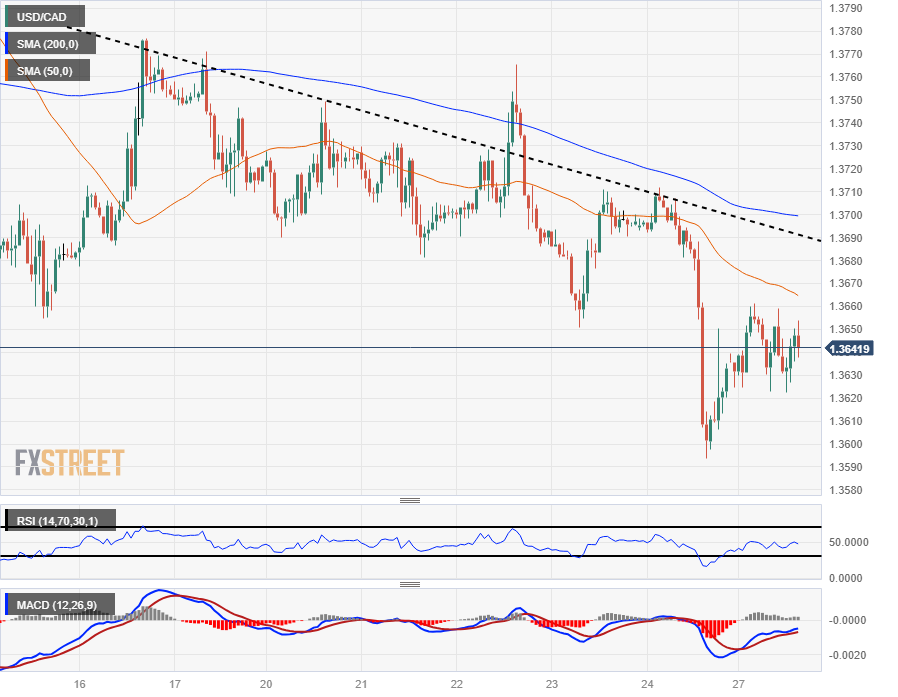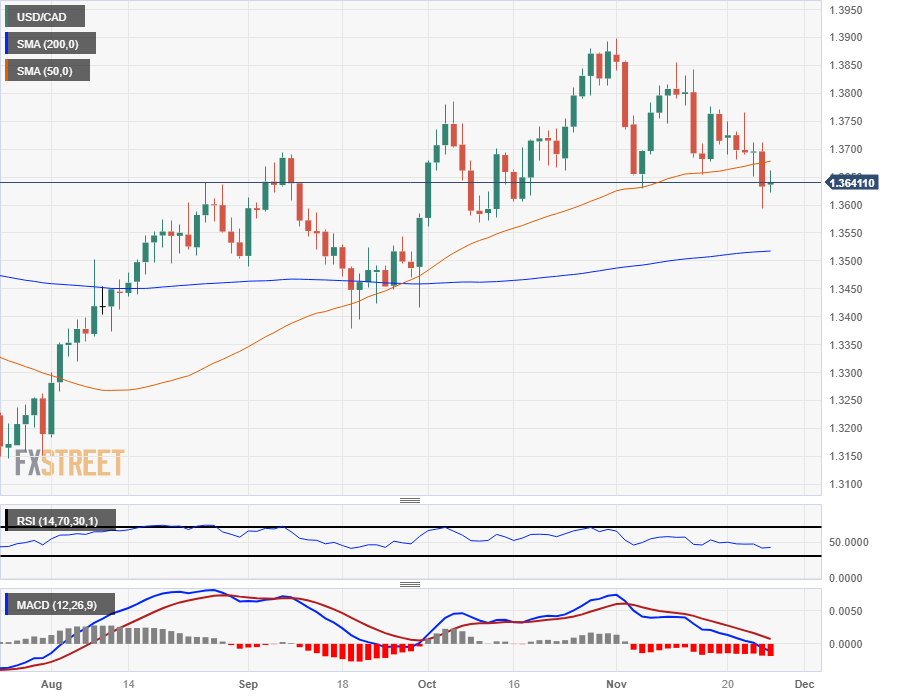Canadian Dollar sees churn on thin Monday as markets look ahead to midweek data

- The Canadian Dollar is grappling with sideways momentum on Monday.
- Markets look ahead to key data for both the US and Canada in the latter half of the week.
- US PCE inflation & ISM Manufacturing, Canada GDP & employment change are on the horizon.
The Canadian Dollar (CAD) is middling against the US Dollar (USD) in early Monday trading, and markets are set for a calmer start to the week before high-impact figures for both the US and Canada begin to print in the back half of the trading week.
Loonie traders will be keeping an eye on Gross Domestic Product (GDP) growth figures from Canada on Thursday, with November’s Canadian Net Change in Employment slated for Friday.
On the USD side of the economic calendar, broader markets will see the FX space driven by US Core Personal Consumption Expenditures (PCE) price inflation on Thursday, as well as US ISM Manufacturing Purchasing Managers Index (PMI) figures on Friday.
Daily Digest Market Movers: Canadian Dollar treads water as markets take a breather before the mid-week data calendar gets underway
- Monday sees flat action on the Canadian Dollar side as investors await headlines or a change in underlying momentum.
- Loonie traders look ahead to Thursday’s Canadian GDP growth, markets expect a rebound to 0.2% annualized growth after the previous quarter’s -0.2% print.
- Canadian data releases to be overshadowed by US figures this week, the main focus will be US PCE inflation numbers for October, expected to show a slight decline in inflation price growth from 3.7% to 3.5% for the annualized period into October.
- US PCE inflation to print alongside Canadian GDP figures at 13:30 GMT on Thursday.
- Friday sees Canadian wages and labor figures alongside November’s US ISM Manufacturing PMI.
- The trading week will cap off with a late Friday appearance from Federal Reserve (Fed) Chairman Jerome Powell, due to participate in a “fireside chat” labeled “Navigating Pathways to Economic Mobility” at Atlanta’s Spelman College.
Canadian Dollar price today
The table below shows the percentage change of Canadian Dollar (CAD) against listed major currencies today. Canadian Dollar was the strongest against the Euro.
| USD | EUR | GBP | CAD | AUD | JPY | NZD | CHF | |
| USD | 0.04% | -0.07% | 0.07% | -0.21% | -0.43% | -0.15% | -0.11% | |
| EUR | -0.06% | -0.13% | 0.01% | -0.26% | -0.50% | -0.21% | -0.16% | |
| GBP | 0.07% | 0.13% | 0.14% | -0.13% | -0.36% | -0.08% | -0.04% | |
| CAD | -0.06% | -0.02% | -0.13% | -0.27% | -0.49% | -0.21% | -0.18% | |
| AUD | 0.20% | 0.27% | 0.13% | 0.27% | -0.23% | 0.05% | 0.11% | |
| JPY | 0.43% | 0.50% | 0.30% | 0.50% | 0.23% | 0.30% | 0.33% | |
| NZD | 0.17% | 0.21% | 0.08% | 0.23% | -0.05% | -0.28% | 0.05% | |
| CHF | 0.10% | 0.14% | 0.04% | 0.18% | -0.10% | -0.32% | -0.04% |
The heat map shows percentage changes of major currencies against each other. The base currency is picked from the left column, while the quote currency is picked from the top row. For example, if you pick the Euro from the left column and move along the horizontal line to the Japanese Yen, the percentage change displayed in the box will represent EUR (base)/JPY (quote).
Technical Analysis: Canadian Dollar grinds sideways as markets await a spark in the headlines
The Canadian Dollar (CAD) is caught in a tight range between 1.3660 and 1.3630 against the US Dollar (USD) for Monday’s trading window.
The USD/CAD is currently capped by the 50-hour Simple Moving Average (SMA) descending into 1.3665, with intraday support currently priced in at the day’s lows near 1.3620.
Near-term bullish momentum will see a technical ceiling at the 200-hour SMA drifting into the 1.3700 handle, and rallies could see bidders getting caught in a short squeeze, though a topside break of last Friday’s peak of 1.3712 will see a shift in the lower-highs pattern.
On the daily candlesticks, the USD/CAD remains trapped under the 50-day SMA, and the pair is drifting toward the median at the 200-day SMA, just north of the 1.3500 handle.
USD/CAD Hourly Chart
USD/CAD Daily Chart
GDP FAQs
A country’s Gross Domestic Product (GDP) measures the rate of growth of its economy over a given period of time, usually a quarter. The most reliable figures are those that compare GDP to the previous quarter e.g Q2 of 2023 vs Q1 of 2023, or to the same period in the previous year, e.g Q2 of 2023 vs Q2 of 2022.
Annualized quarterly GDP figures extrapolate the growth rate of the quarter as if it were constant for the rest of the year. These can be misleading, however, if temporary shocks impact growth in one quarter but are unlikely to last all year – such as happened in the first quarter of 2020 at the outbreak of the covid pandemic, when growth plummeted.
A higher GDP result is generally positive for a nation’s currency as it reflects a growing economy, which is more likely to produce goods and services that can be exported, as well as attracting higher foreign investment. By the same token, when GDP falls it is usually negative for the currency.
When an economy grows people tend to spend more, which leads to inflation. The country’s central bank then has to put up interest rates to combat the inflation with the side effect of attracting more capital inflows from global investors, thus helping the local currency appreciate.
When an economy grows and GDP is rising, people tend to spend more which leads to inflation. The country’s central bank then has to put up interest rates to combat the inflation. Higher interest rates are negative for Gold because they increase the opportunity-cost of holding Gold versus placing the money in a cash deposit account. Therefore, a higher GDP growth rate is usually a bearish factor for Gold price.

